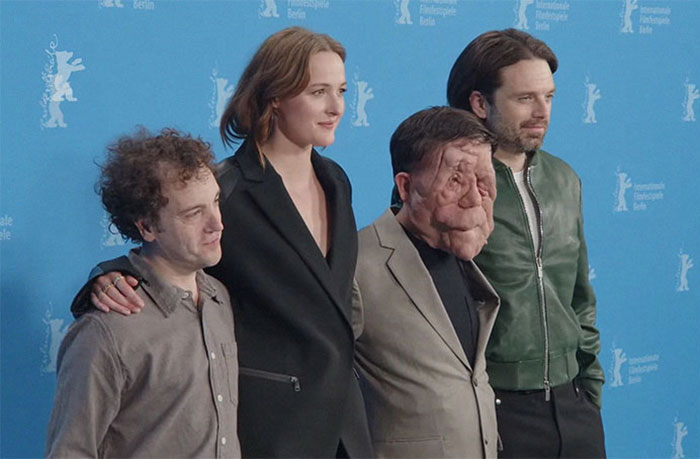British actorAdam Pearsonis telling thestories about disabilitythat he wants to see in Hollywood.
In thefilm, set to be released September 20, Adam plays Oswald, an actor with facial disfigurement who is cast to portray Edward (Sebastian Stan), an aspiring actor with similar disfigurement, in a stage production based on Edward’s life.
HighlightsAdam Pearson stars in the dark comedy A Different Man, aiming to destigmatize facial disfigurement.Adam lives with neurofibromatosis type 1 (NF1), a genetic disorder causing tumors that affects 1 in 3,000 people worldwide.The actor criticizes Hollywood for “lazy writing” about disabilities and advocates for more disabled voices in creative processes.
RELATED:
Adam Pearson hopes to destigmatize facial disfigurement with his new film,A Different Man

Image credits:IMDB
Adam previously worked alongsideScarlett Johanssonin the 2014 thrillerUnder the Skinand Schimberg’s 2019 filmChained for Life.
“I’m liked, and luckily, people seem to get on board with what I do,” the London-born actor, who has jokingly referred to himself as “God’s favorite disabled guy,” toldPeople Magazine.
“I think if I’m not educating, I’m being reckless and irresponsible,” said the British actor, who lives with neurofibromatosis type 1

Image credits:Adam Pearson
Adam believes Hollywood creators produce “lazy writing” to tell stories about people withdisabilities.
“I don’t think there are enough disabled voices feeding into the creative process,” he said.
“I get frustrated when people pretend they can’t find them. Granted, you don’t have to, but then don’t be surprised when what you make is garbage.”
Adam was five years old when he was diagnosed with neurofibromatosis type 1, an incurable genetic disorder that involves the entire nervous system (brain, spinal cord, and peripheral nerves) and can cause tumors.
View this post on Instagram
NF1 is a common form ofneurofibromatosis, accounting for 96% of cases. It affects an estimated 1 in 3,000 births worldwide annually, as per theCleveland Clinic.
It has “variable manifestations,” explains Dr. Jaishri Blakeley, director of the Johns Hopkins Comprehensive Neurofibromatosis Center.
The most common manifestations of the condition are cognitive challenges and tumors in deep nerves or in nerves that go to the skin.

By the time Adam was eight, the tumors had progressed, and he was bullied at school for his appearance, a situation that continued until high school.
“Secondary school was particularly painful. I’d take a deep breath before walking through the gates and try to hang on.”
In the film, Adam plays Oswald, an actor with facial disfigurement who is cast to portray Edward (Sebastian Stan), an aspiring actor with a similar condition

Image credits:Berlinale – Berlin International Film Festival
The actor never pitied himself for having NF1. “You can get bogged down in, ‘It’s not fair. Why is life so cruel?’ It doesn’t solve anything.”
He still gets a lot of stares on the street—some are simply curious, while others are ill-intentioned.
“I think an honest conversation goes a long way,” said Adam.
“Curiosity should be answered with kindness. All people want is to know that you’re okay and that they’re going to be okay. After that, it’s plain sailing.”

He continued: “If people want to talk, let’s talk. I know some in thedisabled communitysay, ‘It’s not my job to educate you about disability.’ But we’re the experts.
“I think if I’m not educating, I’m being reckless and irresponsible.”
“We wanted to make something that changed how people think rather than what they think, and create conversation and debate,” Adam said
His big screen appearances also serve an educational purpose, as they contribute to destigmatizing the condition.
“My disability has opened way more doors than it’s closed,” Adam said.
“If what I’m doing now means that younger Adam Pearsons don’t have to walk through hell in school or that someone who looks like me can walk into a pub, and it isn’t a big deal, then I’ve accomplished my goal.”
Last February, after the film’s premiere at the Berlin Film Festival, Sebastian Standefended his co-starfrom a reporter who used the word “beast” to describe people with facial disfigurement.
“I think that’s one of the things the film is saying — we have these preconceived ideas, and we’re not really educated on how to understand this experience in particular,” Sebastian responded.Linas Simonaitis
Aurelija Rakauskaitė
Saimonas Lukošius
Entertainment